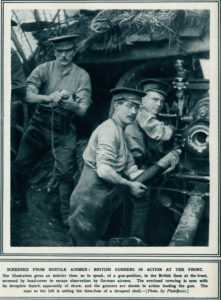Wednesday February 6th, 1918
Day work again. Iron rations. Canteen stuff comes in very handy. Very quiet, wonder if war is over, very cold. (This line was scored through. Ed.) Johnny give us a very warm time. I thought our time had come when shell burst over us but came out safe. Worst bombardment experienced since coming.
Canteen Comfort
It is interesting to note that, despite being on the dreaded iron rations again, Frank doesn’t moan much about it. I think this is because he can supplement his diet of beef stew and hard biscuits with the provisions he bought at the Canteen. This shows the importance of Canteens to the morale of the men. They were a touch of home comfort in a foreign land. This was probably especially important on the Macedonian Front: In the middle of a windswept and sparsely populated land, the troops had nowhere to visit even if they were granted leave.
Bombardment
In his diary, Frank first speculates that the war is over, because everything seems quiet. Presumably the subsequent bombardment forced him to score this through. From his description, it isn’t easy to guess what type of shell was being used in this instance.
There were three primary shell types in WWI, each of which had its own pros and cons (if that is acceptable terminology for weapons of war):

Shrapnel These shells required line of sight to the target (aka direct fire) with an optimal range of one to two miles. As the name suggests they were stuffed with projectiles, detonated by a fuse that had to be set before firing and were designed to injure and kill people. The British liked them best. Partly because, in support of an attack, as long as the advancing allies were behind the shells when they detonated, the troops would be safe from injury. However, they required time and precision in setting the fuse for each shell; they often failed to destroy the enemy’s barbed wire (a key role of artillery) and were expensive.
This photograph shows a camouflaged gun position. The two on the right are loading the gun while the gunner on the left is setting the time fuse of a shrapnel shell.*
High Explosives (HE) These shells could be lobbed high into the air, travel several miles and didn’t require line of sight to the target. They detonated on contact and were capable of causing huge damage to both structures and people. All Armies used them though they were the missile of choice for the Germans in most military

situations. Because they detonated on contact, they didn’t need a separate fuse and therefore required less adjustment. However their lack of precision was one of the reasons the British didn’t like them in support of an attack – as the circular blast meant that they could injure and kill their own troops. They also churned up the earth, creating huge craters which then had to be navigated by the advancing troops. Furthermore, if they hit something soft (e.g. the mud of Flanders) they would not explode. Over the course of the war, the manufacturers adjusted the ratio of shell to contents as they found that a fragmenting shell could wound and maim as effectively as a shrapnel shell.
This photograph shows the damage that could be done by a high explosive shell. The man on the right is standing in the bottom of the crater.
Canisters These were capable of carrying gas. A variety of delivery mechanisms were tried for this new weapon. The Germans fired gas in liquid form in 15cm howitzer shells against both the Russians and the French in early 1915 with mixed results. In the same year, both sides used cylinders and hoses to release gas on the Western Front. Both had problems with self-inflicted gassing caused by changes in wind direction, most infamously when the British Army gassed many of its own troops at Loos in September. Ultimately, gas payloads were put into artillery shells. This increased the target range, ensured that the gas landed well into enemy territory and increased the range of gases that could be used in warfare.
As a close witness to such destructive power, it is no wonder Frank reported that he thought his ‘time had come’.
13th (Service) Battalion War Diary – 6th February 1918 – Vladaja Camp
Every effort is being made to get all ranks of the Battalion passed through the gas chamber during the period the Battalion is in Brigade Reserve. 1 OR having rejoined is again taken on effective strength from 5-2-18. 2 OR struck off effective strength under GRO 1011 with effect from 6-2-18.
References & Further Reading
* British Gunners in Action on the Front, 1914 from The Illustrated War News, December 23, 1914, image could be subject to copyright in some domains.
** Photograph from the papers of Field Marshall (Earl) Haig, National Library of Scotland
Shrapnel Shells, Wikipedia
Weapons of War – Poison Gas on First World War.com


